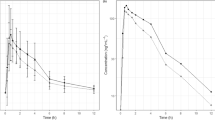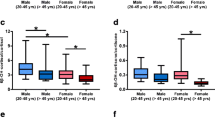Summary
It has been established that human cytochrome P450 (CYP) enzymatic activity is affected by gender, or by hormonal factors such as the menopause in women. Gender differences have a more pronounced effect on cytochrome (CYP) 3A4 isoenzyme activity, whereas cytochrome (CYP) 1A2 isoenzyme activity is mainly induced by chronic smoking. Lidocaine is frequently used in the treatment of hemodynamic changes following laryngoscopy and tracheal intubation during general anesthesia, and is metabolized by CYP3A4 and CYP1A2 isoenzymes in the liver.
The aim of this study was investigate the effects of gender and menopause on serum lidocaine levels in smokers under general anesthesia. Six men, six premenopausal women and six postmenopausal women were enrolled in the study and received i.v. lidocaine (1 mg/kg) 1 minute before they underwent general anesthesia. Serum lidocaine concentrations were measured using the EMIT® method at 1, 5, 10, 20, 40 and 60 minutes post-administration. Statistical analyses were performed using the Mann-WhitneyU-test.
No statistically significant differences were found regarding the area under curve (AUC(0−60) μg/mL/min), elimination half-life (t1/2 [min]) of lidocaine and in the measured levels of serum lidocaine at any time point between the study groups (p>0.05). These results suggest that gender and menopause may have no significant effect on serum lidocaine levels in smokers.
Similar content being viewed by others
References
Yukioka H, Hayashi M, Terai T, et al. (1993): Intravenous lidocaine as a suppressant of coughing during tracheal intubation in elderly patients. Anesth Analg 77: 309–312.
Hamaya Y, Dohi S (2000): Differences in cardiovascular response to airway stimulation at different sites and blockade of the response by lidocaine. Anesthesiology 93(1):95–103.
Wang JS, Backman JT, Taavitsainen P, et al. (2000): Involvement of CYP1A2 and CYP3A4 in lidocaine N-demethylation and 3-hydroxylation in humans. Drug Metab Dispos 28:959–965.
Tanaka E (1999): Gender-related differences in pharmacokinetics and their clinical significance. J Clin Pharmacol Ther 24(5):339–346.
Meibohm B, Beierle I, Derendorf H (2002): How important are gender differences in pharmacokinetics? Clin Pharmacokinet 41(5):329–342.
Zaigler M., Rietbrock S, Szymanski J, et al. (2000): Variation of CYP1A2-dependent caffeine metabolism during menstrual cycle in healthy women. Int J Clin Pharmacol Ther Toxicol 38 (5):235–244.
Zevin S, Benowitz NL (1999): Drug interactions with tobacco smoking. Clin Pharmacokinet 36:425–438.
Imaoka S, Enomoto K, Oda Y, et al. (1990): Lidocaine metabolism by human cytochrome P-450s purified from hepatic microsomes: comparison of those with rat hepatic cytochrome P-450s. J Pharmacol Exp Ther 255:1385–1391.
Relling MV, Lin JS, Avers GD, et al. (1992): Racial and gender differences in N-acetyltransferase, xanthine oxidase, and CYP1A2 activities. Clin Pharmacol Ther 52:643–658.
Lane HY, Chang YC, Chang WH, et al. (1999): Effects of gender and age on plasma levels of clozapine and its metabolites: analyzed by critical statistics. J Clin Psychiatry 60 (1):36–10.
Huet PM, Lerorier J (1980): Effects of smoking and chronic hepatitis B on lidocaine and indocyanine green kinetics. Clin Pharmacol Ther 28:208–215.
Elmas T, Mavioğlu Ö, Öztekin S, et al. (2003): The effect of propofol (anesthetic and inhibitor of CYP3A4) on serum lidocaine concentrations in smokers and chronic alcohol consumers. Int J Clin Pharmacol Ther Toxicol 41(4):182–184.
Hunt CM, Westerkam WR, Stave GM (1992): Effects of age and gender on the activity of human hepatic CYP3A. Biochem Pharmacol 44:275–283.
Kashuba ADM, Bertino JS, Rocci ML et al. (1998): Quantification of 3-month intra-individual variability and the influence of sex and menstrual cycle phase on CYP3A activity as measured by phenotyping with intravenous midazolam. Clin Pharmacol Ther 64:269–277.
Yun CH, Wood AJ, Guengerich FP (1992): Identifiction of the pharmacogenetic determinants of alfentanil metabolism: cytochrome P-450 3A4. An explanation of the variable elimination clearance. Anesthesiology 77:467–474.
Gustavson LE, Legier UF, Benet LZ (1986): Impairment of prednisolone disposition in women taking oral contraceptives or conjugated estrogens. J Clin Endocrinol Metab 62:234–237.
Harris RZ, Tsunoda SM, Mroczkowski P, et al. (1996): The effects of menopause and hormone replacement therapies on prednisolone and erythromycin pharmacokinetics. Clin Pharmacol Ther 59(4):429–435.
Author information
Authors and Affiliations
Rights and permissions
About this article
Cite this article
Oztekin, S., Mavioglu, O., Elar, Z. et al. The effects of gender and menopause on serum lidocaine levels in smokers. European Journal of Drug Metabolism and Pharmacokinetics 30, 231–234 (2005). https://doi.org/10.1007/BF03190625
Received:
Issue Date:
DOI: https://doi.org/10.1007/BF03190625




